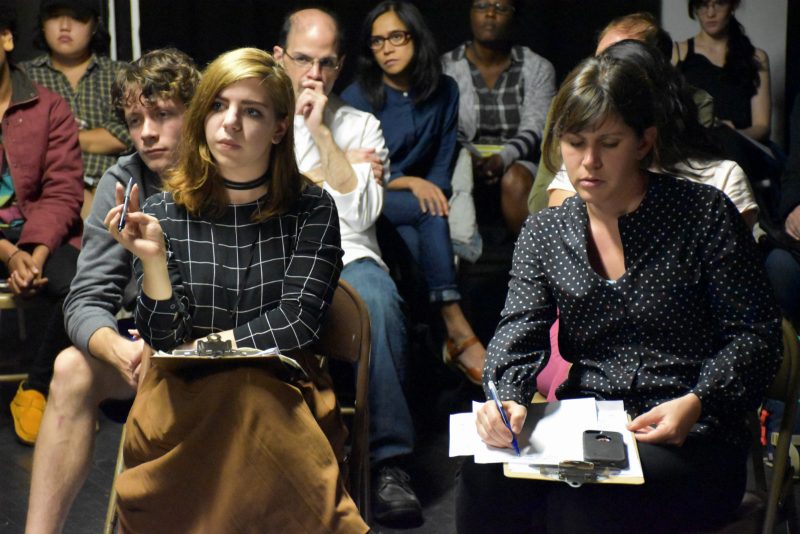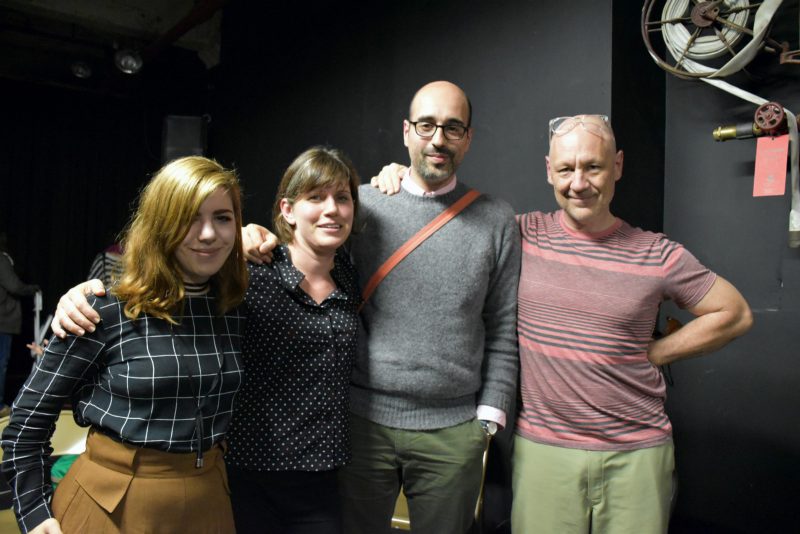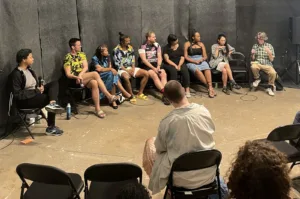(ED. NOTE: THIS POST BY ANNA MARIE GIBERTINI WAS ORIGINALLY PUBLISHED OCT. 12, 2016)
As a hopeful arts journalist and recent graduate of Syracuse University’s Goldring Arts Journalism program, I think about the question of just what art criticism is and what purpose it fulfills daily. I recently learned I wasn’t the only one looking for the answers.

On September 28, a group of approximately 30 people gathered in Vox Populi’s black box performance space to talk about art criticism, as part of the 2016 New Art Writing Challenge sponsored by Artblog and The St. Claire. The panel comprised: Hammam Aldouri, writer, essayist, and philosopher; John Muse, artist, educator, and researcher; and Meredith Sellers, artist, educator, and writer. The discussion was moderated by artist, educator, and St. Claire co-director Suzanne Seesman. Matt Kalasky of The St. Claire manned the pop-up bar.
Criteria or Culture?
The conversation kicked off with an investigation of criteria — how do we evaluate art and what is criticism anyway? In the past, art critics could rely on an established canon of methodologies to digest and assess the quality of the art they took in. During my master’s program, I took a class in art literature methodology so I could understand what a piece meant beyond how I reacted to it personally. But that methodology, according to the panelists, is now outdated.
Post-structuralism, a variant of Continental philosophy that insists on the meaninglessness of authorial intent and on an endless variety of interpretation, has rendered any conversation about aesthetics moot, argued Aldouri. We cannot return to any kind of universal agreement on what is good and what is bad art. Is criticism therefore a pointless activity because we have no single rubric with which to judge? For Muse, art criticism should be about cultivating and building culture, not simply establishing a rubric of quality.

Cultivating that culture is a difficult and intricate pursuit, argued Sellers. As a writer (she writes for Hyperallergic although she eschews the title “art critic,” preferring to be called an “art writer”), she spoke of the difficulty in growing Philadelphia’s art scene due to the lack of art-specific publications in the area. But as an artist, Sellers noted that the art infrastructure in Philadelphia isn’t friendly to artists because of that very lack.
“A show could be here today, gone tomorrow and no one would know,” she said.
Gate-Keepers
These issues mean that art critics (and writers) essentially act as vital gatekeepers – if they do not view and write about art, the gap between artists and their public will not be bridged and Philadelphia’s art culture will not blossom. Writing about art is no small feat, though.

During the Q&A, an audience member wondered if visual arts criticism was significantly different than other forms of criticism, like that of film or music. Seesman argued that it was, as “the art object is more complicated than any other kind of cultural artifact.” If we believe that art has endless and divergent interpretations, then, writing about art cannot be like writing about a movie, which (usually) has a plot and characters that will be understood similarly across audiences; or music, which has straightforward emotional power that can be interpreted clearly by all.
Muse joked that art’s slippery and endless interpretations were why he didn’t write much about art. “It’s hard!” he said.
The conversation went into other nooks and crannies and ended with more questions than answers, but I think that is the best outcome. Writing is hard, but worthwhile. As funding for the arts founders, it’s more important than ever to keep writing and keep investigating these questions of meaning and quality. Even if answers don’t become obvious, the persistent quest for meaning by art practitioners themselves and by arts writers will help the arts stay at the culture table rather than be relegated to the basement as irrelevant.
(ED. NOTE: This post by Anna Marie Gibertini originally published on Artblog Oct. 12, 2016)








